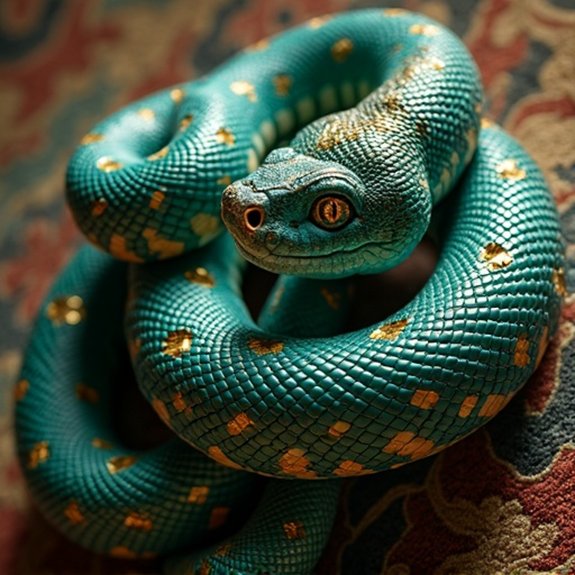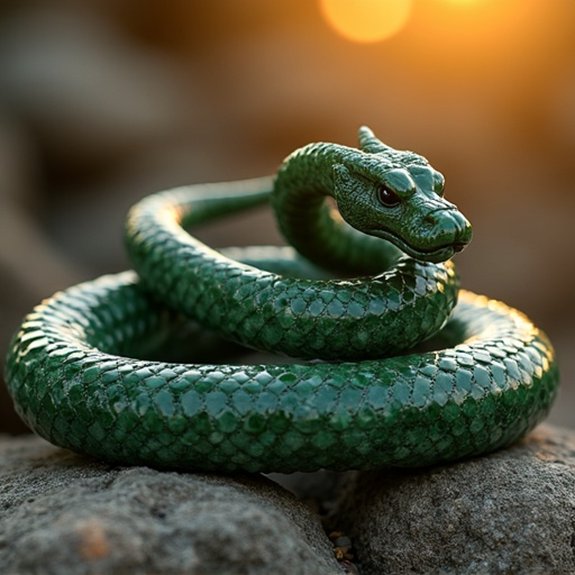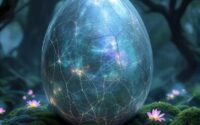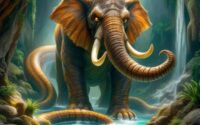The Twin Serpents Across Cultures
The twin serpents‘ coiled forms appear in sacred spaces from ancient Mesopotamia to modern meditation halls. They’ve marked royal seals, crowned healing staffs, and traced energy paths up countless spines. While scholars debate their origins, these intertwined creatures persist across millennia and continents. What drives humanity’s obsession with this particular symbol? The answer lies buried in cylinder seals, temple walls, and the collective unconscious of civilizations that never met.
Introduction

When ancient civilizations gazed at the stars, carved their sacred symbols, or wove their creation myths, they often depicted two serpents intertwined or facing each other in eternal balance. This recurring motif appears across continents and millennia, from Mesopotamian temples to Mesoamerican pyramids, suggesting humanity’s shared fascination with dual serpentine imagery.
The twin serpents represent fundamental dualities: creation and destruction, healing and harm, wisdom and temptation. They’ve adorned medical staffs, royal regalia, and religious texts. Ancient Greeks honored them in the caduceus, while Hindu traditions celebrate the ida and pingala energy channels. Aboriginal Australians speak of the Rainbow Serpent’s dual nature.
These symbols transcend mere decoration. They encode philosophical teachings about balance, transformation, and the cyclical nature of existence that resonates across disparate cultures.
Ancient Mesopotamian Cylinder Seals
Although cylinder seals served primarily as administrative tools in ancient Mesopotamia, they’ve preserved some of the earliest known depictions of twin serpents in human history. These small stone cylinders, rolled across wet clay to create impressions, date back to 3500 BCE. Artisans carved intricate scenes featuring intertwined serpents flanking deities, particularly those associated with fertility and medicine.
The serpents often appeared as guardians of sacred spaces or divine beings. One notable example from the Akkadian period shows twin snakes coiling around a central staff, prefiguring later medical symbols. Scholars interpret these paired serpents as representing duality—life and death, chaos and order, or healing and harm. The seals’ widespread distribution across Mesopotamian trade routes helped disseminate this iconography throughout the ancient Near East, influencing subsequent cultures’ serpent symbolism.
Notable Cases or Sightings

Several documented encounters with twin serpent phenomena have captured researchers’ attention throughout history, though distinguishing between mythological accounts and actual observations remains challenging. In 1547, German chronicler Conrad Lycosthenes recorded villagers’ testimony about two intertwined serpents emerging from Lake Constance during a thunderstorm. They’d reportedly circled each other before vanishing beneath the water’s surface.
Mexico’s Xochimilco canals produced multiple sightings between 1890 and 1920, where witnesses described paired water snakes moving in perfect synchronization. Local fishermen called them “cuates sagrados” or sacred twins. Similarly, India’s Sundarbans region has generated consistent reports since the 1800s of cobra pairs performing coordinated defensive displays near ancient temple ruins. While skeptics attribute these accounts to misidentification or folklore embellishment, the geographic distribution and temporal consistency of such reports continue to intrigue anthropologists studying cross-cultural serpent symbolism.
Common Theories or Explanations
Researchers have proposed multiple frameworks to explain the widespread twin serpent phenomenon across cultures. Carl Jung’s theory of collective unconscious suggests these symbols emerge from shared human archetypes, representing fundamental dualities like creation and destruction. Others point to astronomical observations—ancient peoples might’ve witnessed rare atmospheric phenomena or interpreted celestial movements as serpentine forms.
Anthropologists favor diffusion theory, arguing that trade routes spread these myths from a single origin point. Meanwhile, neurological explanations focus on entoptic phenomena—geometric patterns the brain generates during altered states that resemble intertwined snakes.
Some scholars propose practical origins: twin serpents could symbolize rivers, DNA’s double helix structure intuited through spiritual experiences, or represent the human nervous system’s bilateral symmetry. Each theory attempts to decode why disparate cultures independently developed remarkably similar serpentine symbolism.
Frequently Asked Questions
How Do Twin Serpent Symbols Differ Between Eastern and Western Religious Traditions?
Eastern traditions often depict twin serpents as kundalini energy rising through chakras or yin-yang balance, while Western traditions show them as healing symbols like the caduceus or representing dual nature’s good versus evil conflict.
What Role Do Twin Serpents Play in Modern Medical and Pharmaceutical Symbolism?
Twin serpents form the caduceus, which medical organizations mistakenly adopted as their symbol. They’ve confused it with the Rod of Asclepius, medicine’s true emblem featuring one snake. Pharmacies worldwide still display this incorrect dual-serpent imagery.
Are There Any Cultures That View Twin Serpents as Exclusively Negative Symbols?
No culture views twin serpents as exclusively negative symbols. While Christianity sometimes associates serpents with evil, even there they’re not uniformly negative. Most cultures recognize dual aspects, representing both danger and wisdom, death and healing.
How Are Twin Serpents Depicted in Indigenous Art of the Americas?
Indigenous American art depicts twin serpents as powerful symbols of duality, balance, and cosmic forces. They’re woven into textiles, carved on temples, and painted on pottery, representing fertility, water, transformation, and the connection between earthly and spiritual spheres.
What Psychological Interpretations Exist for Recurring Twin Serpent Dreams or Visions?
Psychologists interpret twin serpent dreams as representing internal conflicts between opposing forces within one’s psyche. They often symbolize the struggle between conscious and unconscious minds, transformation processes, or the integration of shadow aspects requiring balance.


